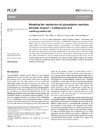Identificador persistente para citar o vincular este elemento:
https://accedacris.ulpgc.es/handle/10553/74868
| Campo DC | Valor | idioma |
|---|---|---|
| dc.contributor.author | Azofra Mesa, Luis Miguel | en_US |
| dc.contributor.author | Alkorta, Ibon | en_US |
| dc.contributor.author | Toro-Labbé, Alejandro | en_US |
| dc.contributor.author | Elguero, José | en_US |
| dc.date.accessioned | 2020-10-19T13:06:03Z | - |
| dc.date.available | 2020-10-19T13:06:03Z | - |
| dc.date.issued | 2013 | en_US |
| dc.identifier.issn | 1463-9076 | en_US |
| dc.identifier.uri | https://accedacris.ulpgc.es/handle/10553/74868 | - |
| dc.description.abstract | The mechanism of the SN2 model glycosylation reaction between ethanol, 1,2-ethanediol and methoxymethanol has been studied theoretically at the B3LYP/6-311+G(d,p) computational level. Three different types of reactions have been explored: (i) the exchange of hydroxyl groups between these model systems; (ii) the basic catalysis reactions by combination of the substrates as glycosyl donors (neutral species) and acceptors (enolate species); and (iii) the effect on the reaction profile of an explicit H2O molecule in the reactions considered in (ii). The reaction force, the electronic chemical potential and the reaction electronic flux have been characterized for the reaction path in each case. Energy calculations show that methoxymethanol is the worst glycosyl donor model among the ones studied here, while 1,2-ethanediol is the best, having the lowest activation barrier of 74.7 kJ mol1 for the reaction between this one and the ethanolate as the glycosyl acceptor model. In general, the presence of direct interactions between the atoms involved in the penta-coordinated TS increases the activation energies of the processes. | en_US |
| dc.language | eng | en_US |
| dc.relation.ispartof | Physical Chemistry Chemical Physics | en_US |
| dc.source | Physical Chemistry Chemical Physics [ISSN 1463-9076], v. 15, p. 14026--14036 | en_US |
| dc.subject | 2210 Química física | en_US |
| dc.title | Modeling the mechanism of glycosylation reactions between ethanol, 1,2-ethanediol and methoxymethanol | en_US |
| dc.type | info:eu-repo/semantics/article | en_US |
| dc.type | Article | en_US |
| dc.identifier.doi | 10.1039/c3cp51963e | en_US |
| dc.description.lastpage | 14036 | en_US |
| dc.identifier.issue | 33 | - |
| dc.description.firstpage | 14026 | en_US |
| dc.relation.volume | 15 | en_US |
| dc.investigacion | Ciencias | en_US |
| dc.type2 | Artículo | en_US |
| dc.description.numberofpages | 11 | en_US |
| dc.utils.revision | Sí | en_US |
| dc.identifier.ulpgc | No | en_US |
| dc.description.sjr | 1,715 | |
| dc.description.jcr | 4,198 | |
| dc.description.sjrq | Q1 | |
| dc.description.jcrq | Q1 | |
| dc.description.scie | SCIE | |
| item.grantfulltext | open | - |
| item.fulltext | Con texto completo | - |
| crisitem.author.dept | GIR IUNAT: Fotocatálisis y espectroscopía para aplicaciones medioambientales. | - |
| crisitem.author.dept | IU de Estudios Ambientales y Recursos Naturales | - |
| crisitem.author.orcid | 0000-0003-4974-1670 | - |
| crisitem.author.parentorg | IU de Estudios Ambientales y Recursos Naturales | - |
| crisitem.author.fullName | Azofra Mesa, Luis Miguel | - |
| Colección: | Artículos | |
Citas de WEB OF SCIENCETM
Citations
7
actualizado el 25-may-2025
Visitas
55
actualizado el 05-may-2024
Descargas
150
actualizado el 05-may-2024
Google ScholarTM
Verifica
Altmetric
Comparte
Exporta metadatos
Los elementos en ULPGC accedaCRIS están protegidos por derechos de autor con todos los derechos reservados, a menos que se indique lo contrario.
